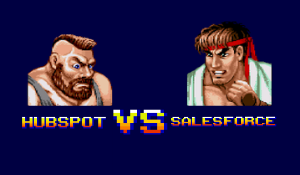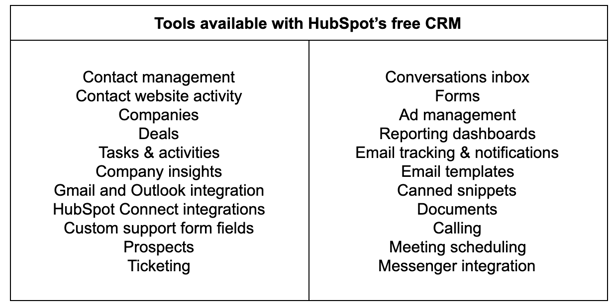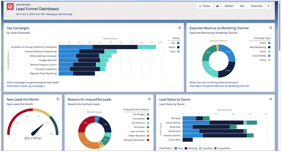






If you’re currently considering between either a HubSpot or Salesforce CRM for your business, then you need to know these four things:
- How easy is it to implement?
- How simple is it to use?
- Can it grow with my business?
- How much will I need to spend?
But every business is different. And if after reading this you think Salesforce is the right solution for you, then go for it. Seriously. If Salesforce lines up with your infrastructure, processes and future plans, don’t waste a second longer. Take the plunge. The sooner you get started the quicker you can grow!
But if you’re still unsure, then let’s dive in...
How easy is it to get started?
HubSpot
If this is your first CRM, implementing HubSpot couldn’t be easier. Just head to HubSpot, download their free (yes, free) CRM tool and away you go. It really is that easy. And thanks to an intuitive front-end dashboard, you can start tracking customer interactions and gain valuable insights into consumer behaviour almost straight away.
(You can have a HubSpot portal with calling functionality, marketing automation and detailed dashboard reporting up and running in about 6 hours.)
You’re probably wondering why it's free? Well, it’s because HubSpot’s business model is based on customer not vendor needs. You only pay for what you use. With HubSpot’s free CRM you can manage up to 1,000,000 contacts with unlimited users always knowing you have the option to scale up to more services as and when required. But HubSpot’s free CRM does cover your basic contact administration, deal task management, social and email functionality.

It’s also worth noting HubSpot CRM includes free versions of some of the most popular features from HubSpot’s Marketing, Sales and Service Hubs - such as email marketing, live chat, CTA forms, ads, reports, and more. Although, if you want to make the most of the HubSpot platform, then you’ll need to upgrade to the paid services to access the more robust tools. But more on that later.
Salesforce
Salesforce CRM is contact and account management with the capability of recording all sales activity in a central hub. If you’re a large outfit in need a heavyweight CRM solution capable of handling huge volumes of data, then Salesforce is a great choice.
However, because unlike HubSpot Salesforce offers no ‘freemium’ option, then you’ll have to put your hand in your pocket from day one.
Also, because Salesforce is a complex beast, if you want to start straight away (by that we mean within a few months, not days!) then you’ll need either an experienced Salesforce user already on-site or be willing to pay a consultant to show you the ropes. Likewise, even though much like HubSpot Salesforce is a cloud-based tool, it isn’t as simple to plug straight into your current tech stack and many larger organisations often find they need the services of either a Business or Technical analyst to make sure the platform integrates with the current set-up.

How easy is it to use?
HubSpot
We’ve worked with HubSpot for the last five years, so trust us when we say the user is always the first priority when HubSpot design their tools. We often have clients up and running on HubSpot on day one with most commenting on the frictionless transition.
The user interface is easy to navigate, intuitive, and simple. And because the HubSpot CRM has been designed as a fully integrated business platform capable of managing your Marketing, Sales and Services functions, many of the core skills are transferable across the entire platform - which means minimal disruption to your business and a smooth transition of leads from marketing to sales.
Not only that, but the HubSpot Academy is also arguably one of the best FREE marketing and sales training resources on the internet. It’s a wealth of content brought to you by in-house HubSpot professors and expert users and it’s a great way to both onboard new staff and up-skill your existing team.
Salesforce

There’s no getting around it, the learning curve for Salesforce is steep. If its main strength is processing industrial amounts of customer data, then its main weakness is the time it takes to master. But that said, after a few months, once it is fully integrated, suitably customised, and your staff have been trained on how to use it, the Salesforce CRM is similar to HubSpot in terms of Dashboard navigation.
But remember! If you want to add marketing functionality to your Salesforce CRM, then you need to fork out extra for Pardot (Salesforce’s own Marketing Platform), which again means another learning curve as you get to grips with yet another system.
Can it grow with my business?
HubSpot
What you need from a CRM today is likely different from what ten or twenty years from now. Not just because your company is going to grow, but because the technology in your business will assuredly advance. You need to make sure any technology you decide to deploy today is a) scalable or b) easy to replace. One of the key reasons so many of our clients prefer HubSpot is its flexibility on both counts.
HubSpot breaks down into three modular and fully interactive components known as ‘Hubs’:
Marketing
Create, schedule and analyse marketing campaigns.
Sales
Track all your pipeline business.
Service
Deliver effective customer satisfaction post-sale.
Because you can choose to implement any or all of the Hubs depending on your needs, you can build a client management system to suit. Yes, HubSpot works best when deployed wholesale across all three functions (Marketing, Sales & Service), but its modular design lets you scale up or down as required.
Salesforce
Talking about Salesforce’s ability to scale is tricky, mainly because one of its major drawbacks for most small and medium business is the fact it’s too big to start with. It’s like trying to drive a tank when you only need a bike. But if you are planning large-scale growth, then Salesforce won’t hold you back (considering it’s explicitly designed for large sales teams handling industrial levels of data).

How much will I need to spend?
It's important to mention costing up either model is difficult as it depends entirely upon what you need it to do. This isn't us passing the buck, we just don't want to give you the wrong information. Your best bet is to go to both websites and price up exactly which services you need and for how many users.
But here's a rough guide:
HubSpot
As already mentioned, the HubSpot CRM is completely free. For zero outlay you can manage your entire sales pipeline through a clean, visual dashboard using tools such as email tracking, prospect tracking, meeting scheduling, live chat, plus more.
But also as previously mentioned, if you want to make the most of the HubSpot platform, then you need to upgrade to HubSpot’s paid Hub services.
Starter
Basic
Professional
Enterprise
This means how much HubSpot costs depends on how much you need it to do. Are you a small start-up just looking to centralize your data? Then Free or Starter is ideal. Slightly bigger than a one-person-band? Maybe between 10-25 employees? Then HubSpot Pro is what you’re after. But what if you’re a 50+ employee organization looking to step up into the Enterprise world? Well, then you’re going to need more firepower in your CRM and you’ll be better served by the Enterprise option.
It used to be said that Enterprise was Salesforce’s domain and HubSpot took care of the SME market. But not any more. Thanks to HubSpot’s impressive expansion plans and product upgrades their platform can now handle some serious data.
Salesforce
Much like HubSpot, the ultimate cost for Salesforce depends on what you need it to do. But to keep it simple, Salesforce runs a conventional software-as-a-service (SaaS) model, charging a monthly subscription fee (billed annually) based on both the number of users and required tier.
Likewise, as already discussed, unlike HubSpot if you want your CRM to also manage your marketing function, then you’re also going to have to also purchase Salesforce’s external Marketing platform, Pardot (which as we’ve already mentioned isn’t cheap and neither is it particularly easy to use).
Hubspot vs Salesforce
HubSpot
HubSpot is a dependable all-round marketing platform designed to let both marketing and sales teams get started quickly with minimal disruption. HubSpot is an ideal solution for both SME and Enterprise outfits alike wanting a user-friendly straight out-of-the-box solution and whose business strategy is to grow through strategic inbound marketing campaigns based around strong blog and social media content.
Salesforce
If you’re a large enterprise outfit with deep pockets, and if you have enough technical resources to make it work, then Salesforce is a great CRM option. It’s powerful, customisable, and comes with a heft of support.








